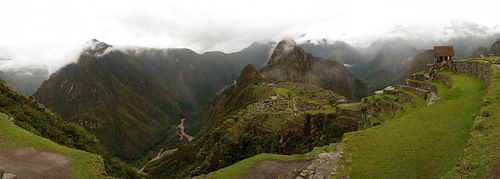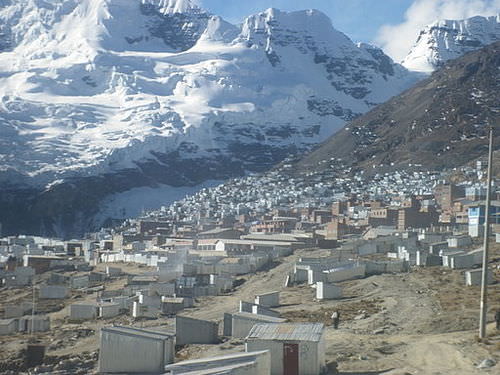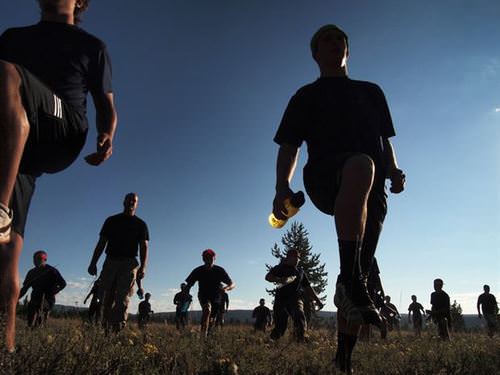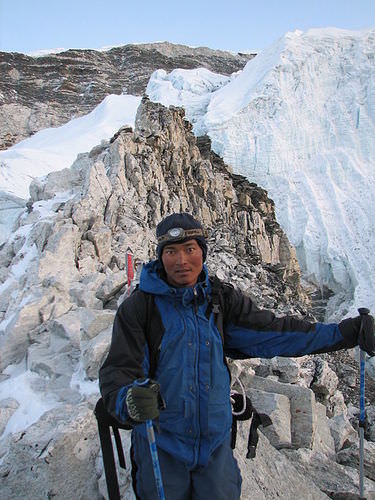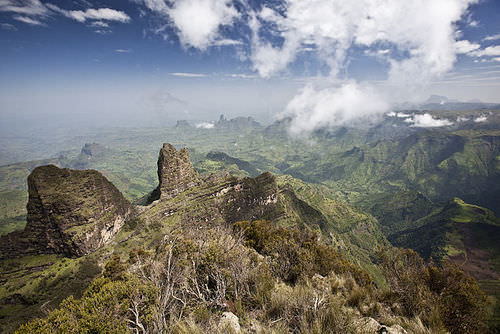8.8 人类应对高海拔的对策
章节大纲
-
High and Hypoxic
::高、 高、 高、 高、 高、 高、 高、 高、 高、 高、 高、 高、 高、 高、 高、 高、 高、 高、 高、 高、 高、 高、 高、 高、 高、 高、 高、 高、 高、 高、 高、 高、 高、 高This mountain scene in the Peruvian Andes is a sight to behold. L urking behind the beauty of this and some other mountain ranges, however, is a potentially deadly threat to the human organism : high-altitude hypoxia. Hypoxia is literally a lack of oxygen. It occurs to varying degrees at altitudes higher than about 2,500 meters above sea level. Besides the Andes Mountains in South America, other high altitude regions in the world where hypoxia may occur include the Himalaya Mountains in Asia, the Ethiopian Highlands in Africa, and the Rocky Mountains in North America.
::秘鲁安第斯山脉的这一山脉景象令人目眩。然而,这一山脉和其他一些山脉的美丽背后的裸露对人体生物构成潜在的致命威胁:高空缺氧。天花实际上是缺氧,在海拔约2,500米以上的高度不同程度发生。除了南美洲的安第斯山脉之外,世界上可能发生缺氧的其他高海拔地区包括亚洲的喜马拉雅山、非洲的埃塞俄比亚高地和北美的洛基山脉。Why Hypoxia Occurs at High Altitudes
::为何高海拔地区出现天天天环Although the percentage of oxygen in the atmosphere is the same at high altitudes as it is at sea level, the atmosphere is less dense at high altitudes. This means that the molecules of oxygen (and other gases) in the air are more spread out, so a given volume of air contains fewer oxygen molecules. This results in lower air pressure at high altitude. Air pressure decreases exponentially as altitude increases, as shown in the graph below.
::虽然大气中的氧气百分比在高空与海平面相同,但高空的大气密度较低,这意味着空气中的氧(和其他气体)分子分布得更多,因此某一空气的氧气分子数量较少。这导致高空的空气压力降低。空气压力随着高度升高而急剧下降,如下图所示。At sea level, air pressure is about 100 kPa. At this air pressure, the air is dense and oxygen passes easily from the air in the lungs through into the bloodstream. It is likely we evolved at or near sea level altitudes, so it is not surprising that the generally performs best at this altitude. However, as air pressure decreases at high altitudes, it becomes more difficult for adequate oxygen to pass into the bloodstream, and levels of oxygen start to fall.
::在海平面,气压约为100千帕。在这种气压下,空气密度高,而氧气从空气中从肺部轻而易举地传入血液中。我们很可能在海平面高度或接近海平面高度时进化,因此在这个高度一般表现最佳并不奇怪。 然而,随着高空空气压力下降,充足的氧气进入血液中变得更加困难,氧气水平也开始下降。At 2,500 meters above sea level, air pressure is only about 75 percent of that at sea level, and at five thousand meters, it is only about 50 percent of the sea level value. The latter altitude is about the altitude of the Mount Everest Base Camp and of the highest permanent human settlement (La Rinconada in Peru, pictured ). Altitudes above 2,500 meters generally require acclimatization or adaptation to prevent illness from hypoxia. Above 7,500 meters, serious symptoms of hypoxia are likely to develop. Altitudes above eight thousand meters are in the “death zone.” This is the zone where hypoxia becomes too great to sustain human life. The summit of Everest, with an altitude of 8,848 meters, is well within the death zone. Mountain climbers can survive there only by taking in extra oxygen from oxygen tanks and not staying at the summit very long.
::在海平面2 500米以上,空气压力仅为海平面的75%,在5 000米以下,仅为海平面值的约50%,后者的高度是珠穆朗玛峰基地营和最高永久人类住区的高度(秘鲁的La Rinconada,图象)。海平面超过2 500米,通常需要加速或适应以防止缺氧引起的疾病。超过7 500米,严重缺氧症状有可能发展。高度超过8 000米的地区位于“死亡区 ” 。这里是缺氧过大无法维系人类生命的地区。珠穆朗玛峰峰峰顶峰,高度为8 848米,在死亡区内。登山者只能从氧气罐中提取额外的氧气才能在那里生存,而不会在峰顶上停留很长时间。La Rincondada, Peru — the highest permanent human habitation
::秘鲁,拉林康达达达——人类最高永久居住地Physiological Effects of Hypoxia
::缺天天病的生理生理影响When a lowlander first goes to an altitude above 2,500 meters, the person’s blood oxygen level starts to fall. The immediate responses of the body to hypoxia are not very efficient, and they place additional stress on the body. The main changes are an increase in the rate (hyperventilation) and an elevation of the heart rate. These rates may be as much as double their normal levels, and they may persist at high levels, even during rest. While these changes increase oxygen intake in the short term, they also place more stress on the body. For example, hyperventilation causes respiratory alkalosis, in which carbon dioxide levels in the blood become too low. The increased heart rate places stress on the and may be especially dangerous for someone with an underlying heart problem.
::当低地人首先到达超过2500米的高度时,人的血液氧气水平开始下降。身体对缺氧的即时反应效率不高,给身体造成额外的压力。主要的变化是心率(呼吸力)的上升和心脏率的升高。这些比率可能高达正常水平的两倍,甚至可能维持在高水平上,甚至在休息期间。这些变化在短期内增加了氧气的摄取量,但也给身体造成更大的压力。例如,高通风导致呼吸道肺病,血液中的二氧化碳含量太低。 心率的上升给心脏带来压力,对心脏有潜在问题的人来说可能特别危险。The first symptoms of hypoxia the lowlander is likely to notice is becoming tired and out of breath when performing physical tasks. Appetite is also likely to decline, as nonessential body functions are shut down at the expense of maintaining rapid breathing and heart rates. Other symptoms are also likely to develop, such as headache, dizziness, distorted , ringing in the ears, difficulty concentrating, insomnia, nausea, and vomiting. These are all symptoms of high altitude sickness .
::低地人可能注意到的最初缺氧症状在做体力活时已经疲惫和喘不过气去,食欲也有可能下降,因为非必要的身体功能被关闭而牺牲了保持快速呼吸和心率。 其他症状也有可能出现,如头痛、头晕、扭曲、耳鸣、注意力困难、失眠、恶心和呕吐。这些都是高海拔疾病症状。More serious symptoms may also develop at high altitudes. F luid collects in the lungs (high altitude pulmonary edema, or HAPE) and in the brain (high altitude cerebral edema, or HACE). HACE may result in permanent brain damage, and both HAPE and HACE can be fatal. The higher the altitude, the greater the likelihood of these serious high altitude disorders occurring, and the greater the risk of death.
::高海拔地区也可能出现更严重的症状。流体在肺部(高高度肺水肿,或HAPE)和脑部(高高度脑水肿,或HACE)中聚集。HACE可能导致永久性脑损伤,HAPE和HACE都可能致命。 高海拔地区越高,这种严重高海拔紊乱发生的可能性越大,死亡风险也越大。Acclimatization to High Altitude
::升至高高度If a lowlander stays at high altitude for several days, the body starts to respond in ways that are less stressful. These responses are the result of acclimatization to high altitude. Additional red blood cells are produced and the tiniest , called capillaries, become more numerous in muscle tissues . The lungs also increase slightly in size, as does the right ventricle of the heart, which is the heart chamber that pumps blood to the lungs. All of these changes make the processes of taking in oxygen and transporting it to more efficient.
::如果低地人在高空停留数日,身体开始以不那么紧张的方式作出反应。这些反应是高度适应的结果。还产生了更多的红细胞,最微小的称为毛细血管的肌肉组织也越来越多。肺的大小也略有增加,心脏的右心室也略有增加,心脏的右心室是将血液注入肺部的心脏室。所有这些变化都使得吸收氧气并将氧气输送到更有效率的体内。It might occur to you that these changes with acclimatization would improve fitness and performance in athletes, and you would be right. The same changes that help the body cope with high altitude increase fitness and performance at lower altitudes. That’s why athletes often travel to high altitudes to train, and then compete at lower altitudes. The photo shows a high school football team participating in high-altitude training in the Rocky Mountains.
::或许你会觉得这些适应化的改变会改善运动员的体质和表现,而你也是对的。 同样的改变可以帮助身体应对高海拔,提高低海拔的体质和性能。 这就是为什么运动员经常去高海拔训练,然后去低海拔比赛。 照片显示高中足球队参加了在落基山脉的高海拔训练。U.S. marines from a recruiting station lead a high school football team in a daily warm up routine at a high altitude training camp in the Rocky Mountains in Idaho.
::一个招募站的美国海军陆战队 带领一个高中足球队 每天在爱达荷州洛基山脉的 高空训练营Full acclimatization to high altitude generally takes several weeks. The higher the altitude, the longer it takes. Even when acclimatization is successful and symptoms of high altitude sickness mostly abate, the lowlander may not be able to attain the same level of physical or mental performance as is possible at lower altitudes. When an altitude acclimatized individual returns to sea level, the changes that occurred at high altitude are no longer needed. The body reverts to the original, pre-high-altitude state in a matter of weeks.
::完全适应高海拔通常需要几周时间,高度越高,需要的时间就越长。即使适应成功,高海拔疾病症状也大多减少,低地人可能无法达到低海拔时可能达到的身体或精神性能水平,当高度适应个人返回海平面时,就不再需要高海拔时发生的变化。在几周内,身体恢复到原有的高空前状态。Genetic Adaptations to High Altitude
::高海拔遗传适应Well over 100 million people worldwide are estimated to live at altitudes higher than 2,500 meters above sea level. In the table , you can see how these people are distributed in the highest altitude regions around the globe.
::全世界估计超过1亿人口生活在海拔2 500米以上的高度。Human Residing in High Altitude Regions High Altitude Region (millions) Himalaya-Hindukush-Pamir Ranges, Tibetan Plateau (Asia) 78 Andes Mountains (South America) 35 Ethiopian Highlands (Africa) 13 Rocky Mountains (North America) 0.3 Some indigenous populations of Tibet, Peru, and Ethiopia have been living above 2,500 meters for hundreds of generations and have evolved genetic adaptations that protect them from high altitude hypoxia. In these populations, has brought about irreversible, genetically-controlled changes that adapt them to high altitude conditions. As a result, they can live permanently at high altitudes without any, or with only minor, ill effects, even though they are constantly exposed to a level of oxygen that would cause high altitude sickness in most other people. Interestingly, different adaptations evolved in different regions in response to the same stress.
::西藏、秘鲁和埃塞俄比亚的一些土著人口数以百代计生活在2 500多米以上,并发展了保护他们免受高海拔缺氧的基因适应,在这些人口中,带来了不可逆转的、受基因控制的改变,使他们适应高海拔条件,因此,他们可以在高空永久生活,没有任何或只有轻微的有害影响,尽管他们经常接触氧气水平,在大多数其他人中会导致高海拔疾病。 有趣的是,不同区域针对同样的压力也出现了不同的适应。High Altitude Adaptations in Tibetan Highlanders
::西藏高地的高海拔适应Highland populations in Tibet, such as the famous Sherpas who serve as Himalaya Mountain guides (see photo ), have lived at high altitudes for only about three thousand years. Their adaptations to high altitude include an increase in the rate of breathing even at rest without alkalosis occurring, and an expansion in the width of the blood vessels (both capillaries and arteries) that carry oxygenated blood to the cells. These changes allow them to carry more oxygen to their and have a higher capacity for at high altitude. Their adaptations to high altitude occurred very rapidly in evolutionary terms and are considered to be the most rapid process of phenotypically observable evolution in humans.
::西藏高地人口,如著名的担任喜马拉雅山向导的谢尔帕斯人(见照片),在高海拔地区仅居住了3 000年左右,对高海拔地区的适应包括:在不发生藻类病的情况下,即使休息时也增加呼吸速度,不发生肺病,以及扩大带氧化血液到细胞的血管(毛皮和动脉)的宽度,这些变化允许他们携带更多的氧气到他们的体内,高海拔的容量也较高,从进化角度讲,它们适应高海拔的速度非常快,被认为是人类最迅速的可观察到的突变过程。The flushed skin of this Tibetan Sherpa guide is due to the increased arterial blood flow that is a genetic adaptation to high altitude hypoxia in Tibetan highlanders.
::西藏舍尔巴人指南的冲洗皮肤是由于动脉血液流动增加,这是对西藏高地人高海拔缺氧的基因适应。High Altitude Adaptations in Andean Highlanders
::安第斯高山高地的高高度适应Andean highlanders, such as Quechua Native Americans (see photo ), have been living at high altitudes for about 11 thousand years. Their genetic adaptations to high altitude are different than the Tibetan adaptations. They include greater red blood cell volume and increased concentration of hemoglobin , the oxygen-carrying that is the main component of red blood cells. These changes allow somewhat higher levels of oxygen to circulate in the blood without increasing the rate of breathing. Compared with other long-term residents at high altitudes, however, Andean highlanders are the least well adapted and most likely to experience high altitude sickness.
::安第斯高地人,如Quechua美洲原住民(照片),在高海拔地区居住了约11 000年,其基因适应高海拔的情况与西藏适应情况不同,包括红血细胞体积较大,血红蛋白浓度增加,血红蛋白是红血细胞的主要成分,含氧量增加,这些变化允许血液中含氧量稍高一些,但不会增加呼吸率。 然而,与其他高海拔地区长期居民相比,安第斯高地人是最不适应和最可能患高海拔疾病的人。Quechua Native Americans in the Peruvian Andes
::秘鲁安第斯山脉的Quechua土著美国人High Altitude Adaptations in Ethiopian Highlanders
::埃塞俄比亚高地高海拔适应The Ethiopian Highlands (pictured ) are high enough to have brought about genetic adaptations in long-term residents. Populations of Ethiopian Highlanders have lived above 2,500 meters for at least five thousand years, and above two thousand meters for as long as 70 thousand years. Many Ethiopian Highlanders today live at altitudes greater than three thousand meters. However, Ethiopian Highland populations do not appear to have evolved the adaptations that characterize either Tibetan highlanders or Andean highlanders. They do not exhibit the hemoglobin changes or vascular changes of these other highland population, but they do have greater arterial blood oxygen saturation. Research on Ethiopian adaptations to high altitude has just begun and is still very limited, but they appear to have a unique pattern of adaptation.
::埃塞俄比亚高地(图象)高得足以给长期居民带来基因适应。埃塞俄比亚高地人口至少居住了5 000年,超过2 500米,超过2 000米,至少居住了7万年。许多埃塞俄比亚高地人今天生活在3 000米以上的高地。然而,埃塞俄比亚高地人口似乎没有发展出西藏高地人或安第斯高地人的特点。他们没有表现出其他高地人口的血红蛋白变化或血管变化,但他们确实有更大的动脉血液饱和度。关于埃塞俄比亚高地适应的研究刚刚开始,而且仍然非常有限,但它们似乎有着独特的适应模式。Ethiopian Highlands in East Africa
::东非的埃塞俄比亚高地Summary
::摘要-
At high altitudes, humans face the stress of hypoxia, or a lack of oxygen. Hypoxia occurs at high altitude because there is less oxygen in each breath of air and lower air pressure, which prevents adequate absorption of oxygen from the lungs.
::在高空,人类面临缺氧或缺氧的压力,在高空发生缺氧,因为空气呼吸中的氧气减少,空气压力降低,肺部氧气无法充分吸收。 -
Initial responses to hypoxia include hyperventilation and elevated heart rate, but these responses are stressful to the body. Continued exposure to high altitude may cause high altitude sickness, with symptoms such as fatigue, shortness of breath, and loss of appetite. At higher altitudes, there is greater risk of serious illness.
::对缺氧的初步反应包括超通风和心率升高,但这些反应对身体造成压力。 继续高空接触可能导致高海拔疾病,症状如疲劳、呼吸短促和食欲丧失。 在高海拔地区,严重疾病的风险更大。 -
After several days at high altitude, acclimatization starts to occur in someone from a lowland population. More red blood cells and capillaries form and other changes occur. Full acclimatization may take several weeks. Returning to low altitude causes a reversal of the changes to the pre-high-altitude state in a matter of weeks.
::高海拔数天后,低地人口开始出现适应现象。 红血细胞和毛细血管形式以及其他变化更多。 完全适应可能需要几周时间。 回到低海拔状态会在几周内导致高地前状态变化的逆转。 -
Well over 100 million people live at altitudes higher than 2,500 meters above sea level. Some indigenous populations of Tibet, Peru, and Ethiopia have been living above 2,500 meters for thousands of years and have evolved genetic adaptations to high altitude hypoxia.
::西藏、秘鲁和埃塞俄比亚的一些土著居民数千年来一直生活在2,500米以上,并发展了适应高海拔缺氧的基因改造。 -
Different high altitude populations have evolved different adaptations to the same hypoxic stress. Tibetan highlanders, for example, have a faster rate of breathing and wider arteries, whereas Peruvian highlanders have larger red blood cells and a greater concentration of the oxygen-carrying protein hemoglobin.
::不同的高海拔人口对同样的缺氧应激变化了不同的适应。 比如,西藏高地人呼吸速度更快,动脉更宽,而秘鲁高地人红血细胞较大,含氧蛋白血红蛋白浓度较高。
Review
::回顾1. Define hypoxia.
::1. 界定缺氧。2. Why does hypoxia occur at high altitudes?
::2. 为什么缺氧发生在高空?3. Describe the body’s immediate response to hypoxia at high altitude.
::3. 描述身体对高空缺氧的即时反应。4. What is high altitude sickness, and what are its symptoms?
::4. 什么是高海拔疾病,其症状是什么?5. What changes occur during acclimatization to high altitude?
::5. 在达到高海拔时发生什么变化?6. Where would you expect to find populations with genetic adaptations to high altitude?
::6. 你希望在哪里找到具有高海拔基因适应性的人口?7. Discuss variation in adaptations to high altitude in different high altitude regions.
::7. 讨论不同高海拔地区高海拔适应措施的差异。8. Why do you think that adaptations to living at high altitude are different in different regions of the world?
::8. 为什么你认为世界不同地区适应高海拔生活的方式不同?9. U sing human responses to high altitude as an example, e xplain the difference between acclimatization and adaptation.
::9. 以人类对高海拔的反应为例,解释适应和适应之间的区别。10. Genetic adaptations to high altitude have evolved in as short a time span as...
::10. 对高海拔的遗传适应在短短的时间内发生了演变,如...a. one thousand years
::a. 千年b. three thousand years
::b. 三千年c. five thousand years
::c. 5 000年d. 11 thousand years
::d. 11,000年11. True or False: Hypoxia is an adaptation to living at high altitude.
::11. 真实或假:天花是适应高海拔生活的适应。12. True or False: At higher altitudes, the percentage of oxygen in the air is lower.
::12. 真实或假:在高空,空气中的氧气百分比较低。13. True or False: Carbon dioxide levels in the blood can become too low as a result of an initial response to high altitude.
::13. 真实或假:由于对高海拔的初步反应,血液中的二氧化碳水平可能太低。14. Why are most humans not well-adapted to living at high altitudes?
::14. 为什么大多数人类不适应高海拔地区的生活?15. If a person that normally lives at sea level wants to climb a very high mountain, do you think it is better for them to move to higher elevations gradually or more rapidly? Explain your answer.
::15. 如果通常生活在海平面上的人想爬上一座很高的山,你认为他们逐步或更快地向高海拔移动更好吗?解释你的答复。Explore More
::探索更多To learn how and why scientists study high altitude acclimatization and adaptation, watch this video, in which several scientists are interviewed about their work and personal experiences at high altitude.
::为了了解科学家如何和为什么研究高海拔适应和适应,请观看这段录像,其中采访了几位科学家,介绍他们在高海拔地区的工作和个人经历。Learn more about the science of altitude training here:
::学习更多有关高度训练科学的知识: -
At high altitudes, humans face the stress of hypoxia, or a lack of oxygen. Hypoxia occurs at high altitude because there is less oxygen in each breath of air and lower air pressure, which prevents adequate absorption of oxygen from the lungs.
